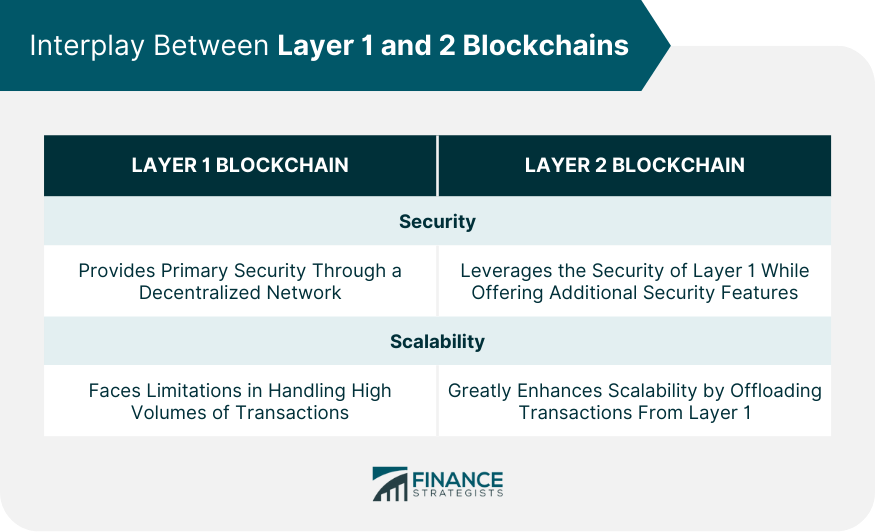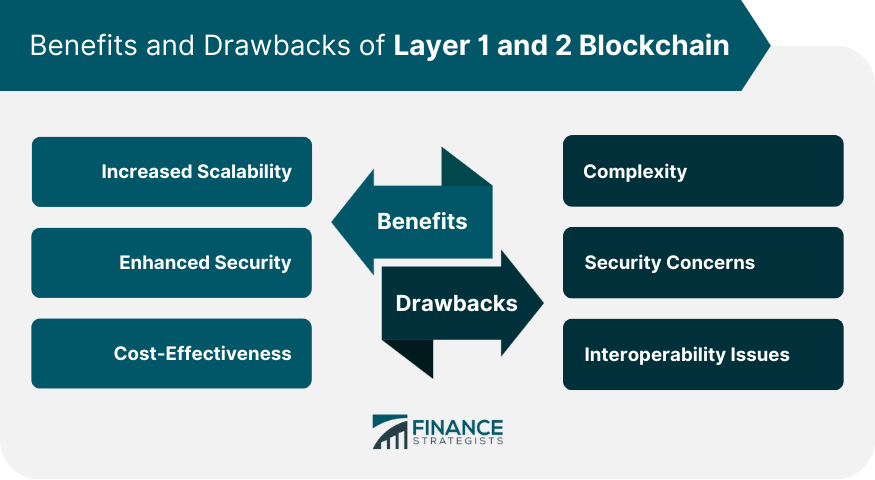Blockchain, a revolutionary technology, is the underlying infrastructure that powers cryptocurrencies like Bitcoin and Ethereum. It operates on different layers to execute transactions, maintain security, and offer a decentralized platform for various applications. The base layer, known as Layer 1, refers to the fundamental blockchain itself. It includes major networks such as Bitcoin's blockchain and Ethereum's blockchain. Meanwhile, Layer 2 blockchain, or simply Layer 2, consists of protocols built on top of the existing blockchain to increase its capabilities. They work off-chain or on side chains, aiming to resolve scalability issues while keeping the security intact. Examples of Layer 2 solutions include Bitcoin's Lightning Network and Ethereum's Plasma. The Layer 1 blockchain serves as the backbone of the entire blockchain ecosystem. It provides security through its decentralized nature and consensus mechanisms, ensuring that transactions are accurately recorded. However, as demand for blockchain technology has increased, scalability issues have become apparent. Layer 2 solutions are designed to overcome these scalability constraints of Layer 1. By processing transactions off-chain or on side chains, they can handle higher transaction volumes faster, and often at lower costs. Layer 2 solutions leverage the security of Layer 1 while providing the capability to accommodate a broader range of applications and services. Layer 1 blockchain operate through a decentralized network of nodes, each maintaining a copy of the entire transaction history. They validate transactions through a consensus mechanism, such as Proof of Work (PoW) in Bitcoin or Proof of Stake (PoS) in Ethereum. This process ensures all nodes agree on the state of the blockchain, maintaining integrity and security. Layer 2 solutions, on the other hand, take various forms such as state channels, side chains, or rollups. These work off-chain or alongside the main blockchain (Layer 1), moving the bulk of transactions away from the congested network. As a result, they can process transactions more quickly and at a lower cost, while still maintaining the underlying security provided by Layer 1. Layer 2 solutions are reliant on Layer 1 for their security. They regularly record a condensed version of their transaction history to Layer 1, allowing them to inherit its robust security. However, this also brings risks. If Layer 1 is compromised, it could also affect Layer 2. Thus, meticulous design and careful maintenance of both layers are paramount to ensure security. The primary role of Layer 2 solutions is enhancing scalability. By operating off-chain or on side chains, they can process a higher volume of transactions without burdening the main blockchain. For example, Lightning Network allows for almost limitless transactions between parties, which are then batched into a single transaction on the Bitcoin blockchain, drastically improving scalability. By shifting the bulk of transactions away from Layer 1, Layer 2 solutions significantly increase scalability. They can handle a much larger volume of transactions, making blockchain technology more practical for widespread use in industries such as finance and supply chain management. Layer 2 solutions can provide additional security features, such as fraud proofs and withdrawal protections, to complement the robust security of Layer 1. They leverage the trustless nature of blockchain, providing users with confidence in the system. Using Layer 2 solutions reduces transaction fees as less computational power is required. This makes blockchain-based applications more affordable, particularly for micro-transactions, enhancing user experience and fostering wider adoption. The introduction of a second layer increases the complexity of blockchain systems. It requires careful design to ensure secure and seamless interaction between layers. Additionally, the technical complexity of implementing Layer 2 solutions can be a barrier to their adoption. Despite leveraging the security of Layer 1, Layer 2 solutions carry their own potential vulnerabilities. For instance, a poorly designed Layer 2 solution could be vulnerable to attacks, endangering both layers. While Layer 2 solutions aim to enhance the capabilities of Layer 1, there may be issues with interoperability. Difficulties in achieving smooth cross-chain communication and challenges in standardization can be hurdles in the widespread adoption of Layer 2 solutions. Blockchain has a myriad of applications. In finance, it can streamline processes, improve transparency, and reduce costs. In supply chain management, blockchain can enhance traceability, reducing fraud and inefficiencies. Decentralized Applications (dApps) built on blockchain can also offer services from decentralized finance (DeFi) to gaming. While blockchain holds promise, real-world implementation presents challenges. There can be technical hurdles in integrating blockchain systems with existing infrastructure. Legal and regulatory concerns can also arise, as blockchain often operates in a legal grey area. Lastly, user adoption can be a challenge, particularly given the complexity and unfamiliarity of the technology. Layer 1 and Layer 2 blockchain solutions have become increasingly relevant in today's digital age, each playing a crucial role in the functionality, security, and scalability of blockchain systems. As the technology continues to evolve, Layer 2 solutions will likely become even more integral in addressing issues of scalability and efficiency. Despite challenges such as increased complexity, potential security vulnerabilities, and interoperability issues, the benefits offered by Layer 1 and 2 blockchain solutions continue to drive their adoption across various sectors, from finance to supply chain management. The future of blockchain technology lies in our ability to effectively leverage and integrate these layers to harness their full potential.What Is Layer 1 and 2 Blockchain?
Purpose and Importance
How Layer 1 and 2 Blockchain Work
Layer 1 Blockchain Functionality
Layer 2 Blockchain Functionality
Interplay Between Layer 1 and 2 Blockchains
Security Considerations
Scalability Solutions

Benefits of Layer 1 and 2 Blockchain
Increased Scalability
Enhanced Security
Cost-Effectiveness
Drawbacks of Layer 1 and 2 Blockchain
Complexity
Security Concerns
Interoperability Issues

Layer 1 and 2 Blockchain in Practice
Use Cases
Real-World Implementation Challenges
Conclusion
Layer 1 and 2 Blockchain FAQs
Layer 1 blockchain refers to the fundamental underlying blockchain itself, like Bitcoin's blockchain or Ethereum's blockchain. Layer 2 blockchain, or Layer 2, are protocols developed on top of the existing blockchain (Layer 1) with the purpose of enhancing its capabilities, often in terms of scalability. They usually work off-chain or on side chains, resolving issues related to transaction speed and volume while keeping the system secure.
Layer 2 blockchain improves scalability by handling transactions off-chain or on side chains, thereby reducing the load on the main blockchain (Layer 1). This allows Layer 2 solutions to process higher volumes of transactions at faster rates, and often at lower costs, making the blockchain more practical for widespread use.
Bitcoin's blockchain and Ethereum's blockchain are examples of Layer 1 solutions. On the other hand, Bitcoin's Lightning Network and Ethereum's Plasma are examples of Layer 2 solutions, which are designed to enhance the scalability of the Layer 1 blockchains on which they're built.
The main challenges faced by Layer 1 and Layer 2 blockchain solutions include increased complexity due to the need for secure and seamless interaction between the two layers, potential security vulnerabilities specific to Layer 2 solutions, and interoperability issues that may arise when trying to achieve smooth cross-chain communication and standardization.
Layer 1 and Layer 2 blockchain solutions find applications in various areas such as finance, where they can streamline processes, and supply chain management, where they can enhance traceability and reduce inefficiencies. They're also crucial in enabling the development of decentralized applications (dApps), which offer services ranging from decentralized finance (DeFi) to gaming.
True Tamplin is a published author, public speaker, CEO of UpDigital, and founder of Finance Strategists.
True is a Certified Educator in Personal Finance (CEPF®), author of The Handy Financial Ratios Guide, a member of the Society for Advancing Business Editing and Writing, contributes to his financial education site, Finance Strategists, and has spoken to various financial communities such as the CFA Institute, as well as university students like his Alma mater, Biola University, where he received a bachelor of science in business and data analytics.
To learn more about True, visit his personal website or view his author profiles on Amazon, Nasdaq and Forbes.











